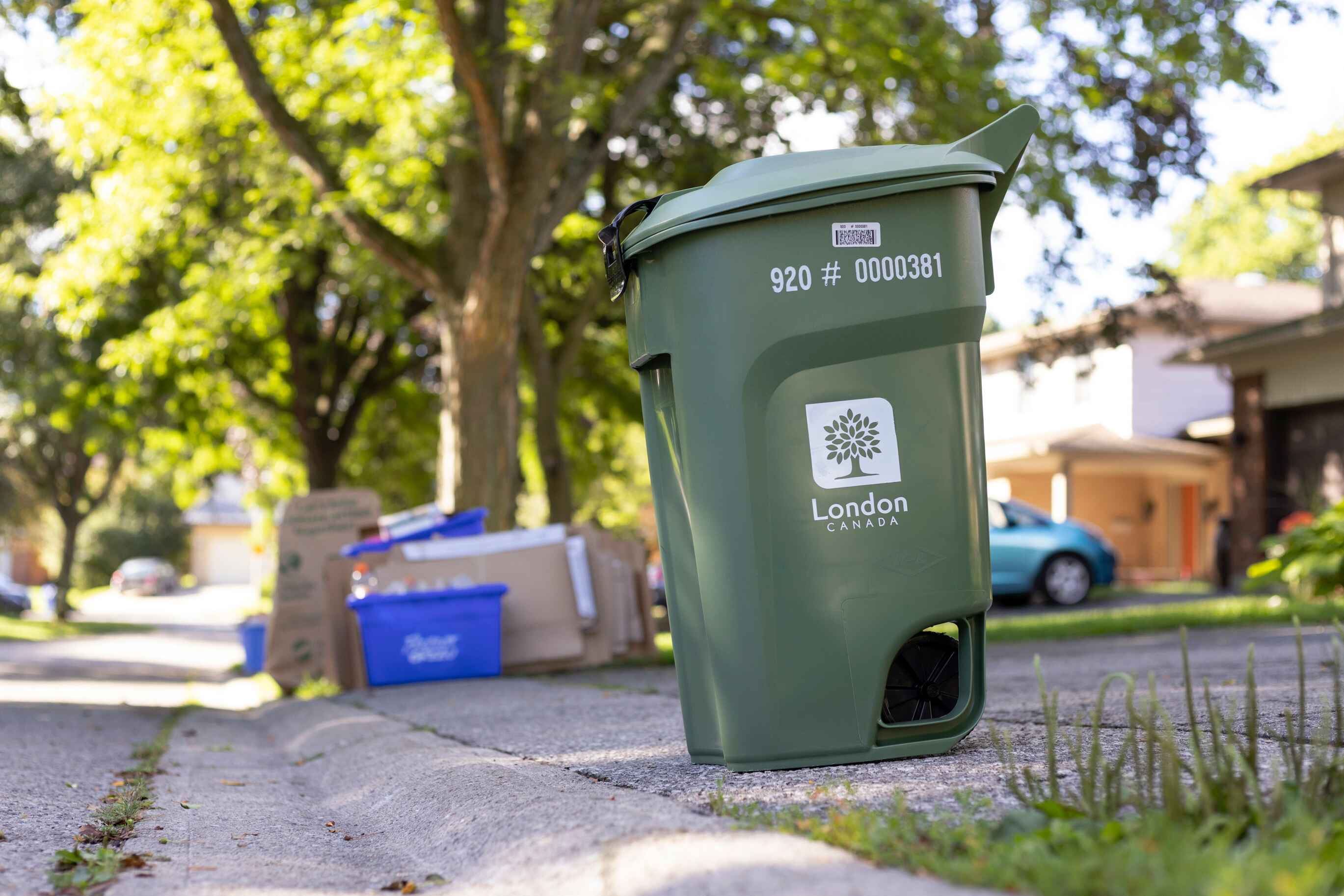
A Green Bin is like a blue (recycling) bin, but for food waste such as fruit and vegetable skins, meat and chicken, spoiled leftovers, and other inedible food waste.
We're continuing to collect from the curb during the recent snow fall. If you've set out garbage, recycling, yard waste bags or your Green Bin for collection, please dig them out and clear snow from container lids, if you can, so we can better see them. Help our collectors, and don't put containers on snow banks. Place them on flat cleared ground. Thank you for your patience as we respond to the snow.
Collection program
How the new Green Bin program works, when and how the materials will be collected, and a list of items that you can put in your Green Bin.
To ensure your Green Bin is collected, please follow the curbside Green Bin program requirements:
- Place the Green Bin at the curbside by 7:00 a.m., but no earlier than 6:00 p.m. the night before collection day.
- Ensure only acceptable materials such as food waste and food-soiled paper products are placed inside the Green Bin. Unacceptable materials include plastic bags and plastic packaging, pet waste, recyclable material and yard waste. For a detailed list of items see below.
- The maximum weight of the Green Bin container is 20 kilograms (44 lbs).
- Ensure Green Bin contents are not sticking or frozen to the sides or bottom of the bin. Green Bins that have frozen contents may not be fully emptied.
Changes to collection frequency
As part of London’s new Green Bin program, the frequency of collection days changed in January 2024.
Green Bins and recycling is picked up at the curb every week. Organic materials such as food waste that can cause odours is collected weekly in the Green Bin.
Garbage is picked up at the curb every other week. This means that Londoners are required to hold onto remaining garbage four to six additional days compared to the current system.
The collection day will remain on the same day each week between statutory holidays. Every statutory holiday, the schedule will move forward one day, meaning collection day will change about 10 times a year instead of every week.
Yard waste collection will still occur every five weeks during the spring and summer and every two to three weeks during the fall.
Check your collection Schedule
How do I set my Green Bin out at the curb for collection?
When your kitchen container is full, or when needed, take it to your Green Bin and empty the materials into the bin. Remember to use the latch on the Green Bin to securely keep it closed. Please do not put your kitchen container curbside for collection or inside of the Green Bin when placing it at the curb. The kitchen container is to be used inside the home. Also, do not place Green Bin materials in a liner at the curb. All Green Bin materials must be inside the Green Bin.
Green Bins are collected weekly. Place your Green Bin at the curb with your garbage and recycling by 7:00 a.m. on your collection day. Do not place your Green Bin at the curb any earlier than 6:00 p.m. the day before collection.
Place the Green Bin at the curb with the latch closed with the opening of the lid facing the street. Set your Green Bin out each week even if partially full.
When placing at the curb, please set beside your garbage. To ensure collection and safety of collection employees, please place your Green Bin on level ground within 1 metre of the curb. Do not place on top of or behind snowbanks.
How to use the Green Bin
Reducing food waste
When food is wasted, so are all of the resources used in its production.
Food production requires a lot of resources. Getting food from the farm to your table requires water, land, fertilizer, and pesticides, as well as fuel for all the machines used in the process. Throughout their lifetime, food can travel thousands of kilometers – from the farm, to processing and distribution centers, grocery stores or markets, and finally, your home.
Each stage of the journey produces greenhouse gas emissions and contributes to global climate change. When food is wasted, all the resources that went into producing the food are also wasted. To make matters worse, discarded food then travels to the landfill where it contributes to methane gas.
There are many ways you can avoid wasting food and reduce your carbon footprint:
- Meal plan - Have a plan for your weekly meals and create your shopping list based on this plan.
- Leftovers - Food is often thrown out because too much is cooked. Reduce how much you prepare, or plan ahead to use any leftovers.
- Know before you go - Know what's in your fridge, freezer and cupboards, and use food up before buying more.
- Buy local - When possible, purchase your food from local suppliers.
Acceptable materials that go in the Green Bin
Food scraps from meal preparations, plate scrapings, soiled paper products and old leftovers when cleaning out the fridge can all go into the Green Bin. All packaging must be removed.
Here is a list of acceptable materials for your Green Bin:
Food waste:
- Baked goods and candy
- Bread, cereal, pasta, noodles, rice, beans and grains
- Coffee filters, grounds and paper teabags
- Dairy products, milk, yogurt, butter and cheese
- Dry baking ingredients, herbs and spices
- Eggs and eggshells
- Fats, cooking oils and food grease (liquid or solid)
- Fruits and vegetables (cooked or raw) including peels, scraps and pits
- Meat, poultry, seafood, giblets and bones
- Nuts and seeds
Food soiled paper products:
- Cardboard egg cartons
- Paper napkins, paper towel and tissues. Those that are contaminated with household cleaners or non-food napkins go into the garbage.
- Paper plates, cups and muffin wrappers (not waxed or lined with plastic)
- Soiled pizza boxes and soiled cardboard
- Soiled paper food packaging not lined in plastic (i.e. paper wrap)
Other items:
- Household plants
- Pet foods
- Pumpkins (please remove all candles and decorations. Set beside Green Bin or cut into pieces and put inside the Green Bin). Painted pumpkins don’t belong in the Green Bin and can be put in the garbage.
- Wooden stir sticks, chop sticks, popsicle sticks and toothpicks
The Recycle Coach App can help answer questions about what goes where in our local waste and Green Bin program. If you are in doubt leave it out of the Green Bin.
Materials that do not go into the Green Bin
These items do not belong in the Green Bin. Please check the Recycle Coach App for information on what to do with them. Most of these items will go into your garbage.
- No plastic bags, plastic packaging, plastic wrap or waxed containers
- Pet waste, kitty litter and all animal bedding
- Hot beverage cups
- Cigarettes
- Baby wipes, diapers, sanitary products
- Chewing gum
- Elastic bands
- Food stickers
- Painted or treated wood
- Cutlery – compostable or plastic
- All plastic items
- Leaf and yard waste
How to store the items in my kitchen
Residents have been supplied with a small container to collect food waste to make collection of organics more convenient. This is typically referred to as a ‘Kitchen Container,’ and it can be used to collect items in your kitchen that can later be placed in your Green Bin. It could be stored on or under your kitchen counter. When the container is full, or when needed, empty the contents into your Green Bin. The container features include a stay-open lid for one-handed operation that residents will appreciate, with a smooth inside finish and removable lid for easier washing.
The Kitchen Container can be washed by hand or in the dishwasher.
How to store your Green Bin
Store your Green Bin in a garage, shed, or somewhere away from direct sunlight and in a convenient location. In the winter months, store it against an exterior wall to prevent ice or snow from building up on the lid.
The curbside bin is equipped with a latching (locking) mechanism that is attached to the lid, to help keep the lid and contents inside more secure. Keep the lid locked (snapped shut) and closed to help deter animals.
Wash your containers as they get dirty. This can help avoid odours. Use a hose to spray your Green Bin out. The Kitchen Container can also be washed by hand, or placed in the dishwasher.
Locking and unlocking your Green Bin
The lid to the Green Bin features a latch to help keep the lid tight.
Keep the lid on your Green Bin securely closed at all times to help prevent pests.
To unlock the bin, press down and then lift. The latch is designed to be opened with the palm of one hand.
Use the correct liner
Using a Kitchen Container or Green Bin liner is optional and not a requirement. The liner may help with preventing material sticking to the bottom of the container, help maintain cleanliness and contain liquids and reduce odours.
There are two types of liner bags that are accepted in the Green Bin:
- Paper liner bags – such as newsprint, paper take-out bags. These bags do not have a certification logo.
- Certified compostable liner bags - look for these symbols when choosing compostable bags:

Please beware! There are other bags that look like certified compostable bags but are not acceptable. Generally, if the label says "biodegradable", "oxo degradable" or "degradable", they are not certified, do not fully compost, and are not accepted in our program.
Plastic bags are not an acceptable liner for the Green Bin or Kitchen Container. Keep all plastics out of the Green Bin.
When setting your Green Bin to the curb for collection and if a liner was used, loosen the liner bag away from the rim, sides and bottom of the bin. This will help with the liner coming out of the Green Bin when it is emptied by collection crews.
My Green Bin was not collected
Your Green Bin may not have been collected for a number reasons including:
- The Green Bin weighed more than 20 kg (44 lbs)
- Your Green Bin was not at the curb by 7 a.m. for collection
- Your organics were not in a proper Green Bin. Please do not use oversized Green Bins (more than 50 litres) or set out your kitchen container at the curb.
- There were a large quantity of unacceptable materials such as plastic bags and plastic packaging.
Ensure Green Bin contents are not sticking or frozen to the sides or bottom of the bin. Green Bins that have frozen contents may not be fully emptied.
How to reduce and prevent odours and liquids
Follow these tips to help reduce and prevent odours and liquids.
- Place your Green Bin out every week even if it’s partially full. This will help with odours and also reduce the amount of time food is in your Green Bin.
- Line your Green Bin with paper products or certified compostable bags if you choose, this will help keep it clean and prevent the contents from sticking or freezing to the sides or bottom of the Green Bin. Loosen the liner away from the rim, sides and bottom as this is will assist collection crews with emptying the Green Bin and having all the contents fall out when emptied.
- Rinse your Green Bin regularly to eliminate odours and keep clean.
- Place spoiled food in your Green Bin just before collection. Consider freezing meat/ bones in paper bags and placing in your bin on collection day.
- Let fats and grease cool and harden first then put them into the Green Bin. Put into a City of London FOG cup and then into the Green Bin. Do not put plastic grease containers into the Green Bin.
- Put layers of paper in your lined Green Bin or lined kitchen container to absorb the liquids. Newspaper, soiled cardboard or shredded paper are all acceptable paper options.
- Use your backyard composter for food waste that has a high liquid content.
How to keep animals and bugs away
Storage of Green Bin
- Place it in a convenient location, likely similar to where you keep your garbage containers and Blue Boxes.
- If possible, store inside a garage or shed.
- Keep your Green Bin away from fences and deck railings so that animals can't get access to your Green Bin.
- If you do place your bin near a fence or deck railing, secure it with a bungee cord so it doesn’t get knocked over.
- Keep the lid on your Green Bin securely closed at all times. Use the latch on the lid and snap it shut.
- If possible, hang the Green Bin on a hook to keep off the ground.
Using the kitchen containers and Green Bin to keep animals and pests away
- Place spoiled food in your Green Bin just before collection. Consider freezing unwanted meat/bones in paper bags and placing in your bin on the morning of collection day.
- Cover food waste with shredded paper or newspaper.
- Roll up into a food soiled paper product.
- Sprinkle a strong smelling biodegradable repellent such as vinegar or detergent on the outside of your Green Bin to help keep pests away.
- In the kitchen, capture fruit flies with a bowl of vinegar covered with plastic wrap with several small holes in it. Empty as required.
- Pour a little (not too much) peppermint oil or hot sauce to act as anti-gnawing repellent and help deter animals from taking an interest in your Green Bin. (Do not use items like cayenne pepper or chili pepper as these items blow around)
- Empty your kitchen container into your green bin on a regular basis.
- Clean your Green Bin and kitchen container as needed. Both can be cleaned with dish soap. The kitchen container is dishwasher safe.
- Set out your Green Bin out to the curb for collection every week, even if it is partially full. (set it out by 7 a.m. on your scheduled collection day).
Winter tips to prevent organics sticking to your Green Bin due to freezing
Here are a few winter tips to help keep your organics from getting stuck to the Green Bin due to freezing:
- Line the bottom of your Green Bin with a layer of soiled cardboard, newspaper, or a paper egg carton to prevent the contents of your Green Bin from freezing to the sides or bottom of the bin and not being fully emptied.
- Drain liquids before you put food scraps into your Green Bin.
- Set your Green Bin out on the curb at 7 am on collection day rather than a night before to reduce the chances of the contents completely freezing.
And if they are stuck and not collected, please help by:
- If materials are frozen inside, it may help to use a shovel or broom handle to loosen up from the sides and bottom of the bin. Please then set back out for collection next week.
- On a sunny day, flip the bin upside down with the lid open to let the materials thaw and fall out.
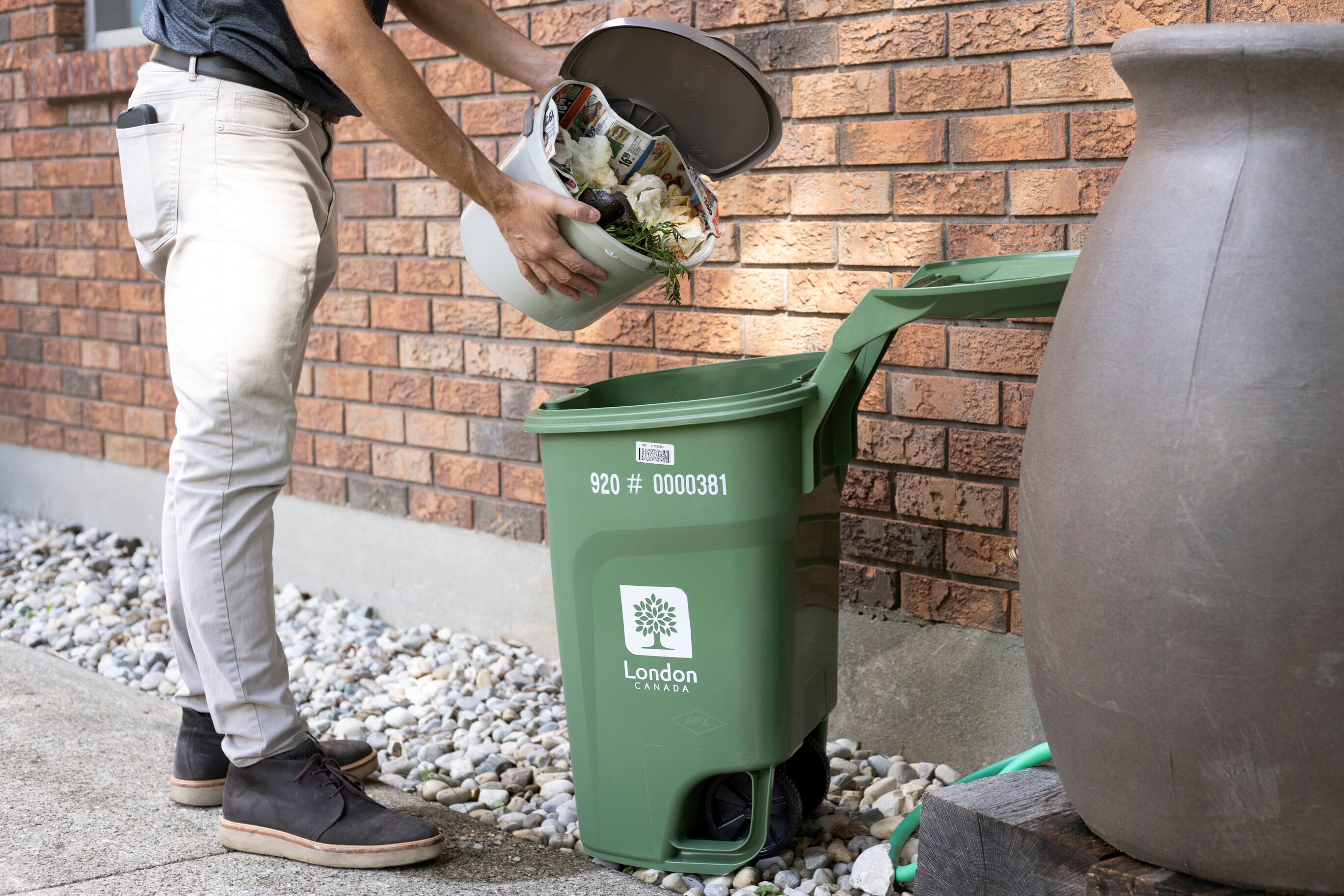
Frequently asked questions
Can I line the Green Bin and Kitchen Container with a bag?
Certified compostable liners, both paper and plastic will be accepted in London’s Green Bin program. To know if a liner is certified compostable please look for the BPI or BNQ logos provided below.

What we do not want in the Green Bin is “compostable packaging” (as stated in our information materials) such as takeout clamshells, wrappers and pouches for some products, knives and forks, plates that look like plastic but state being compostable, etc. It may be difficult to determine the difference in the plastic packaging and plastic ends up in the Green Bin.
In regards to liners, they can be used in and purchased for both the Green Bin (larger size) and the kitchen container (smaller size). Both the Glad and Bag to Earth certified compostable bags are options for liners, as well as other brand name and store brand options. You do not have to use compostable liners, but they can help contain liquids and odours. Paper such as newsprint can also be used to line your containers. Liners can be purchased from hardware and grocery stores, as well as online.
What are the sizes and measurements of the bins?
Green Bins are 45 litres in capacity. There measurements are 68.58 cm (27 inch) to top of handle, 46.99 cm (18.5 inches) in depth, and 40.64 cm (16 inches) in width.
Kitchen Containers are 7 litres in capacity. They are 29.53 cm (11.625 inches) in width, and 23.18 cm (9.125 inches) height and depth.
How were Green Bins delivered to homes?
City-wide distribution is complete. If you are a curbside collected household and have not received a Green Bin please contact the City at service@london.ca or at 519-661-2489 (CITY).
Inside the Green Bin is a copy of the new 2024 Waste Reduction and Conservation Guide. The new Guide contains information on collection dates beginning January 15, 2024, how to use the kitchen container and Green Bin, what materials go inside the Green Bin, what materials must not be placed in the Green Bin, and how and when it should be placed at the curb.
The Kitchen Container is designed to collect organic waste from your kitchen before it goes in the Green Bin. It provides a quick and convenient way for you to collect your food scraps, catch them from accidently going into the garbage, and keep them from causing odours indoors. It could be stored on or under your kitchen counter. When the container is full, contents can then be moved to your Green Bin. Using certified compostable liners for your Green Bin and Kitchen Container will be allowed, but are not required.
Some households who already compost may be familiar with the idea of Kitchen Container, and some families have been using containers or tins already to collect food scraps for their home compost.
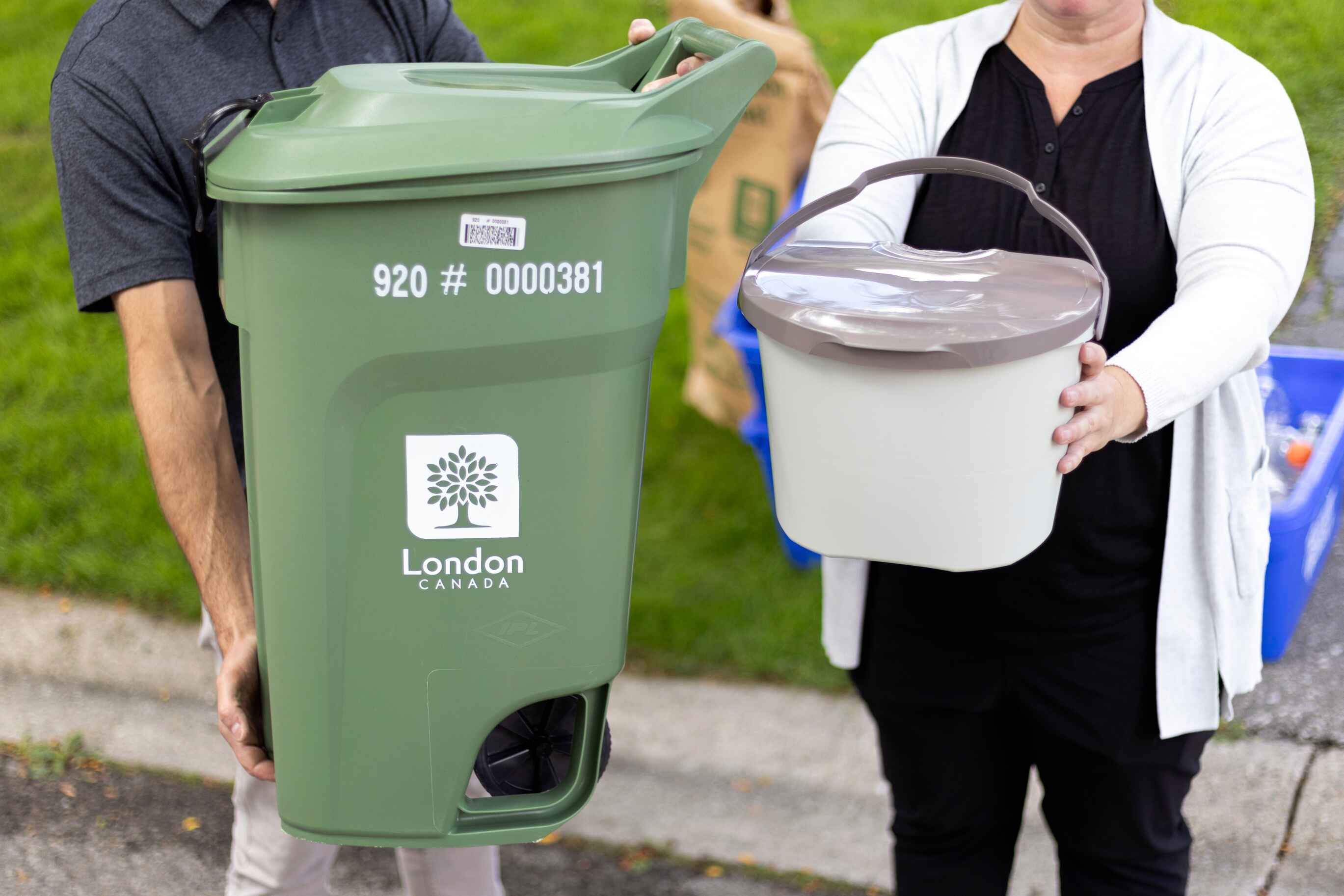
Will the Green Bin program be made available to businesses or business offices?
No, London’s Green Bin program is available for households that receive curbside collection services. The service is not available for businesses.
I live in a multi-family home such as a duplex or triplex, how many Green Bins will I receive?
The City will provide one Green Bin per registered residential unit to residents who place their garbage and recycling at the curb.
A multi-residential location with 12 units or less may receive a Green Bin (45 L in size) unless the address receives multi-residential collection and does not set out to the curb. If that type of collection is provided then the Green Bin Program will be brought online with the apartment Green Bin program roll-out.
Where can I get an additional Green Bin and Kitchen Container?
London households (property owners) will receive one Green Bin and one Kitchen Container. These items belong to the owner of the property. A tenant will be required to leave the Green Bin and Kitchen Container at the property when they leave.
The City of London is working on a plan on how additional Green Bins or Kitchen Containers can be purchased.
If an additional Green Bin is purchased at a local retail location please ensure it is 40 to 50 litres in size. It is important to ensure the correct size is purchased as the collectors physically lift and tip the Green Bins into the collection truck. They cannot empty oversized (greater than 50 litres) or overweight containers (greater than 44 pounds).
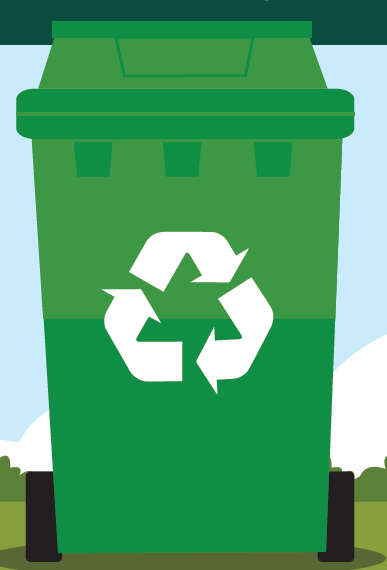
These are not permitted to be used for Green Bin curbside collection:
- The larger size carts have a catch bar in the front of the bin. This style of cart is not for manual collection
- A green garbage can is not permitted for Green Bin collection
Size of container – between 40 and 50 litres. Check the label on the Green Bin Container.
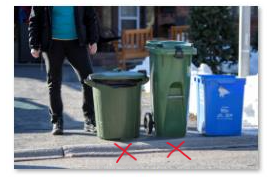
Can I drop-off my Green Bin materials at the EnviroDepots?
No, at this time the EnviroDepots will not have a Green Bin drop-off option.

